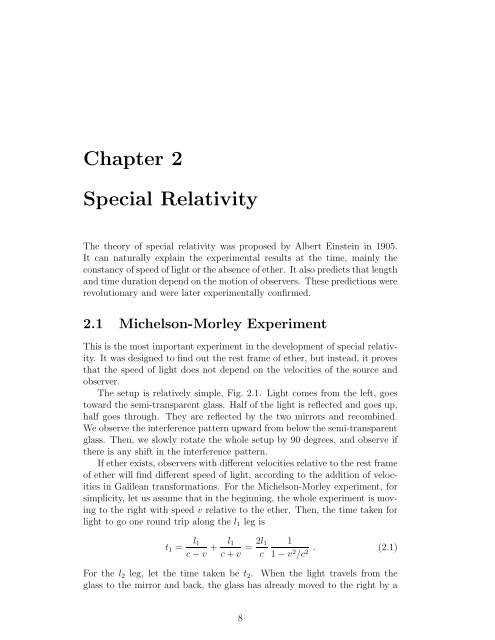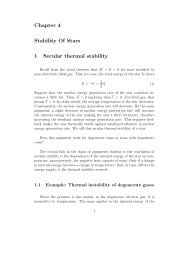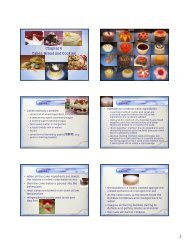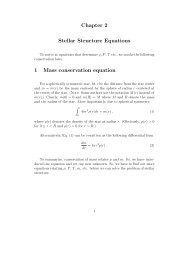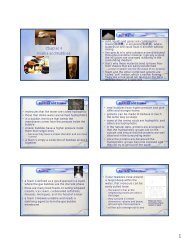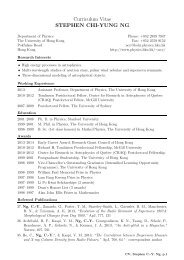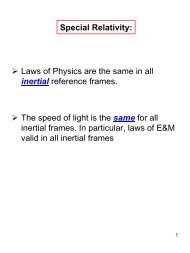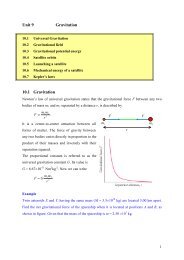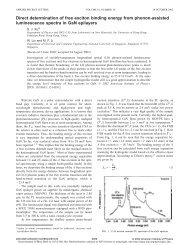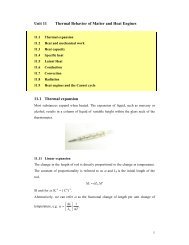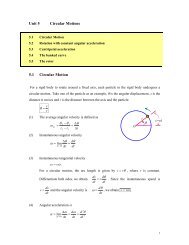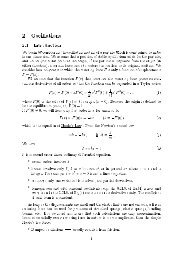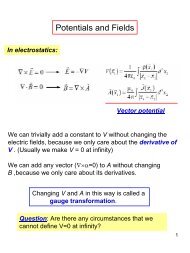here - Department of Physics, HKU
here - Department of Physics, HKU
here - Department of Physics, HKU
You also want an ePaper? Increase the reach of your titles
YUMPU automatically turns print PDFs into web optimized ePapers that Google loves.
Chapter 2<br />
Special Relativity<br />
The theory <strong>of</strong> special relativity was proposed by Albert Einstein in 1905.<br />
It can naturally explain the experimental results at the time, mainly the<br />
constancy <strong>of</strong> speed <strong>of</strong> light or the absence <strong>of</strong> ether. It also predicts that length<br />
and time duration depend on the motion <strong>of</strong> observers. These predictions were<br />
revolutionary and were later experimentally confirmed.<br />
2.1 Michelson-Morley Experiment<br />
This is the most important experiment in the development <strong>of</strong> special relativity.<br />
It was designed to find out the rest frame <strong>of</strong> ether, but instead, it proves<br />
that the speed <strong>of</strong> light does not depend on the velocities <strong>of</strong> the source and<br />
observer.<br />
The setup is relatively simple, Fig. 2.1. Light comes from the left, goes<br />
toward the semi-transparent glass. Half <strong>of</strong> the light is reflected and goes up,<br />
half goes through. They are reflected by the two mirrors and recombined.<br />
We observe the interference pattern upward from below the semi-transparent<br />
glass. Then, we slowly rotate the whole setup by 90 degrees, and observe if<br />
t<strong>here</strong> is any shift in the interference pattern.<br />
If ether exists, observers with different velocities relative to the rest frame<br />
<strong>of</strong> ether will find different speed <strong>of</strong> light, according to the addition <strong>of</strong> velocities<br />
in Galilean transformations. For the Michelson-Morley experiment, for<br />
simplicity, let us assume that in the beginning, the whole experiment is moving<br />
to the right with speed v relative to the ether. Then, the time taken for<br />
light to go one round trip along the l 1 leg is<br />
t 1 = l 1<br />
c − v + l 1<br />
c + v = 2l 1<br />
c<br />
1<br />
1 − v 2 /c 2 . (2.1)<br />
For the l 2 leg, let the time taken be t 2 . When the light travels from the<br />
glass to the mirror and back, the glass has already moved to the right by a<br />
8


